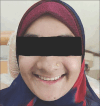Papillon-Lefevre syndrome: Case series
- PMID: 39949702
- PMCID: PMC11819644
- DOI: 10.4103/jomfp.jomfp_25_24
Papillon-Lefevre syndrome: Case series
Abstract
Papillon-Lefevre syndrome (PLS) is an exceptional autosomal recessive disorder characterized by palmoplantar keratinization and premature loss of deciduous and permanent teeth. The palmoplantar keratoderma commonly has its onset between the ages of 1 and 4 years with severe periodontitis initiating at 3 or 4 years old. Parental consanguinity has been demonstrated in 20% to 40% of the cases. Management and preservation of teeth in such patients is a challenge to periodontists. Genetic studies have shown that mutation in the major gene locus of chromosome 11q14.1-q14.3 with the loss of function of the Cathepsin-C (CTSC) gene is responsible for PLS. An early diagnosis of the syndrome can help preserve the teeth through early institution of treatment, using a multidisciplinary approach. We hereby present four cases having all the characteristic features of the syndrome.
Keywords: Palmoplantar hyperkeratosis; Papillon-Lefevre syndrome; periodontitis; precocious loss of the dentition.
Copyright: © 2024 Journal of Oral and Maxillofacial Pathology.
Conflict of interest statement
There are no conflicts of interest.
Figures
















References
-
- Mahajan VK, Thakur NS, Sharma NL. Papillon-Lefevre syndrome. Indian Pediatr. 2003;40:1197–200. - PubMed
-
- Rathi SK. Papillon-Lefevre Syndrome in two brothers. Indian J Dermatol Venerol Leprol. 2002;68:155–6. - PubMed
-
- Gorlin RJ, Sedano H, Anderson VE. The syndrome of palmoplantar hyperkeratosis and premature periodontal destruction of the teeth. J Pediatr. 1964;65:895–908. - PubMed
-
- Cury VF, Costa JE, Gomez RS, Boson WL, Loures CG, De ML. A novel mutation of the cathepsin C gene is Papillon- Lefevre syndrome. J Periodontol. 2002;73:307–12. - PubMed
-
- Haneke E. The Papillon-Lefèvre syndrome: Keratosis palmoplantaris with periodontopathy: Report of a case and review of the cases in the literature. Hum Genet. 1979;51:1–35. - PubMed
Publication types
LinkOut - more resources
Full Text Sources
